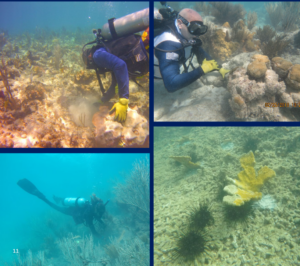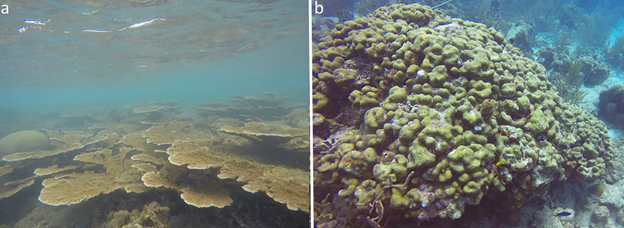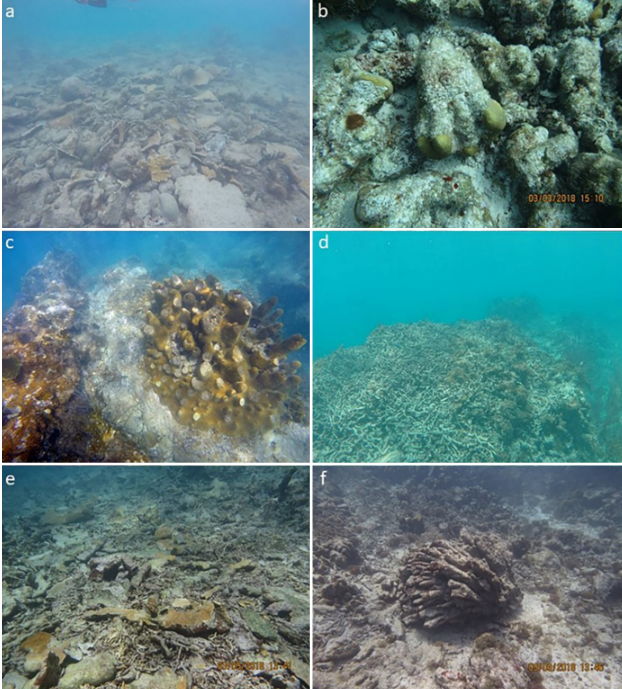In September 2017, major hurricanes Irma and Maria impacted Puerto Rico (PR) and the U.S. Virgin Islands (USVI) and caused considerable damage to shallow coral reefs. A newly released NOAA report summarizes assessments and restoration efforts in PR and the USVI.

Coral reefs buffer coastlines from erosion and inundation by reducing wave energy and wave height, reducing risk to people and infrastructure from wave damage and flooding. In PR and the USVI, coral reefs provide coastal protection for more than 4,500 people with more than an estimated $230,000,000 annually in protection benefits.
Hurricane Irma made landfall in the British Virgin Islands, just east of the USVI, on September 6 with 155 knots/hour* category 5 hurricane. Hurricane Maria made landfall on September 20 in southeastern PR as a high-end category 4 hurricane with 135 knots/hour* winds (*one knot is one nautical mile per hour or 1.15 miles per hour).
In February 2018, at the request of the PR Department of Natural and Environmental Resources, the Federal Emergency Management Agency (FEMA) assigned NOAA to conduct coral reef assessments and emergency coral stabilization activities in PR as part of the Hurricane Maria response. Hurricane damage of destabilized, broken, and loose corals was observed at approximately 12% of shallow reefs assessed in PR. Considerable damage variability was observed between assessment sites in the extent of wave impacts to corals and reefs, likely due to reef exposure to the dominant wave energy and coral species, abundance, size, and morphology.
NOAA assessment and restoration staff assessed 414,354 square meters of coral reef area including over 87,000 corals at 150 sites between February 27 and May 7, 2018 and 8,700 + corals reattached at 35 reef sites across PR. Prior to the FEMA assignment, coral stabilization efforts were supported by NOAA and the National Fish and Wildlife Foundation in PR and St. Thomas, USVI reattaching more than 7,500 corals at 28 additional sites. In total, coral stabilization efforts in PR and the USVI reattached 16,000 corals at 63 sites.

The most severely impacted coral species include four listed as Threatened under the Endangered Species Act): Dendrogyra cylindrus (pillar coral), Acropora palmata (elkhorn coral), Orbicella annularis (lobed star coral), and Acropora cervicornis (staghorn coral).
Stabilization of loose or fragmented corals not only salvages coral colonies but also prevents future additional reef damage when the loose corals or rubble would further mobilize in subsequent tropical storm wave events. Coral stabilization efforts reattached thousands of at-risk corals otherwise perishable. Many reattached corals were fragments from large, slow-growing species hundreds of years old. Saving these large individuals intentionally contributed to maintaining overall coral biomass, ecosystem functionality, wave attenuation potential, and habitat quality for other coral reef organisms (e.g., fish, invertebrates), resulting in local and regional improvements to habitat and species abundance and diversity.
This report summarizes both the pre-FEMA restoration effort in Puerto Rico and the USVI, as well as the FEMA mission assignment to NOAA in PR. The plan for quantitative data collection for both damage assessment and emergency coral stabilization described in the report serves as an example for guiding future efforts.
Citation: Viehman, T. Shay, Michael Nemeth, Sarah H. Groves, Christine A. Buckel, Sean Griffin, Don Field, Thomas D. Moore and Jennifer Moore. 2020. Coral assessment and restoration in the U.S. Caribbean after 2017 hurricanes. NOAA Technical Memorandum NOS NCCOS 278. 64 pp. https://doi.org/10.25923/7r0b-wc52

